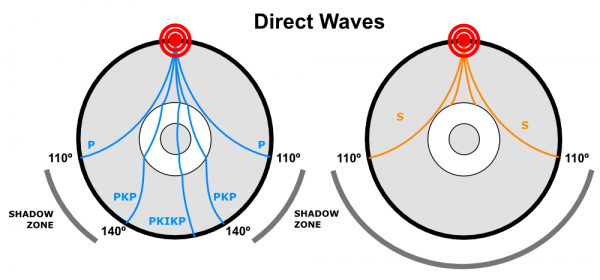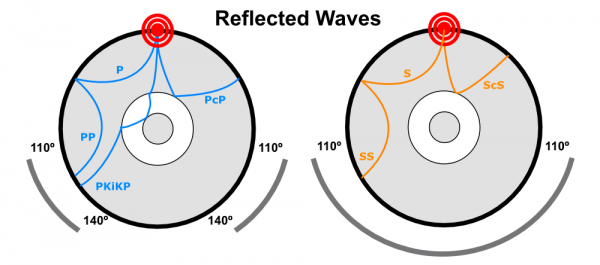![]() Or, more accurately, my department does. And it rather handily picked up last week’s magnitude 8 earthquake near the Santa Cruz Islands (subject of the latest Friday Focal Mechanisms), all the way over in the southwest Pacific. Here’s the seismogram:
Or, more accurately, my department does. And it rather handily picked up last week’s magnitude 8 earthquake near the Santa Cruz Islands (subject of the latest Friday Focal Mechanisms), all the way over in the southwest Pacific. Here’s the seismogram:
At first glance, this looks pretty easy to interpret: the compressional P waves arrive first, just over 20 minutes after the earthquake; the slower transverse (side-to-side motion) S waves kick in around 15 minutes later; and surface waves, which have to travel around the circumference of the earth rather than through it, only got to Ohio around an hour after the initial rupture.
But there is a tiny problem. The smooth passage of earthquake waves through the Earth is disturbed by the presence of the core, which has entirely different physical properties from the overlying mantle. P waves travel much more slowly in the outer core than they do in the lower mantle, and when they cross the core-mantle boundary this abrupt change in speed causes them to be refracted, or bent, to a steeper angle, forcing them deeper into the Earth than they would otherwise have gone. To the P-waves, then, the outer core is a kind of seismic lens: P-waves that would have arrived at seismometers in this “shadow zone” have been bent away, focussed to a point further towards the other side of the Earth from the source earthquake. This means that between 12,000 to 16,000 kilometres from the rupture (or 110 and 140 degrees around a great circle path), you don’t see any P waves that have travelled directly from the rupture to your seismometer . For S-waves, the core is more like a roadblock: no direct S waves are detected anywhere more than 12,000 kilometres (110 degrees) from the source earthquake. This is actually the key piece of evidence that the outer core is liquid: because liquids cannot maintain the shear stresses necessary to transmit tranverse waves, the S waves just peter out when they hit the core mantle boundary.

The paths of P and S waves generated by an earthquake through the mantle. The shadow zones are the result of refraction of P waves away from the surface, and the blocking of S waves, by the outer core. PKP is a wave that has travelled through the outer core; PKIKP is a wave that has travelled through the inner core as well.
And here’s where the problem comes in: if you measure the distance between the Santa Cruz quake and northeast Ohio, we find that we’re more than 110 degrees away: we should be in the shadow zone for direct waves.

If you measure the great circle distance between the Santa Cruz Islands and the Eastern US, you find yourself in the shadow zone.
Clearly something else is going on, and the key word is ‘direct’. Boundaries do not just refract and dissipate waves: they can reflect them too. More shallowly travelling P and S waves can bounce back down into the mantle off the base of the crust and lithosphere, thus diverting around the core and into the shadow zone. While reflections off the core-mantle boundary can’t make it into the shadow zone (at the critical distance, their incident angle has shallowed to the point that they graze the core-mantle boundary rather than reflecting), reflections from the boundary between the inner and outer cores might.

Some ways that P and waves can be reflected into the shadow zone and register on seismometers there.
Another property of boundaries within the Earth is that they can change the nature of the waves that pass through them: when bouncing back down from the crust or up from the core-mantle boundary, or refracting through the core-mantle boundary, P waves can be turned to S waves, and S waves can be turned to P. Some of these waves (such as the SKS wave that is converted to a P wave that travels through the outer core, then converted back to an S wave when it passes back into the mantle again) can also make it into the shadow zone.

Some of the wave conversions that can take place at velocity boundaries within the Earth, such as the Moho and the core-mantle boundary.
It seems, then, that rather than direct P and S waves, it is waves that have taken a more exotic route through the Earth from the Santa Cruz Islands rupture that ended up being picked up in Kent:
People much more qualified at interpreting seismograms seem to agree. IRIS have produced one of their trademark cool animations of the seismic waves from the Santa Cruz Islands quake propogating across the Earthscope transportable array, which has reached the midwest on it’s gradual migration from the west coast to the east. Like the Kent seismometer, the array is picking up seismic waves despite being in the shadow zone, and the seismogram running along the bottom of the screen does indeed label these as converted and reflected phases rather than direct arrivals:
http://youtu.be/jr6ELIjhRMs
It’s funny how things turn out: when I first looked up the Kent seismograph record last week, I thought it would just be a conveniently timed hook to kick off my geophysics lecture on global seismology. But, by being more complicated than I initially thought, it was actually a good reference point for a lot of the material I covered. Oh yes, I am going to enjoy having a seismometer in the basement…



Comments (4)